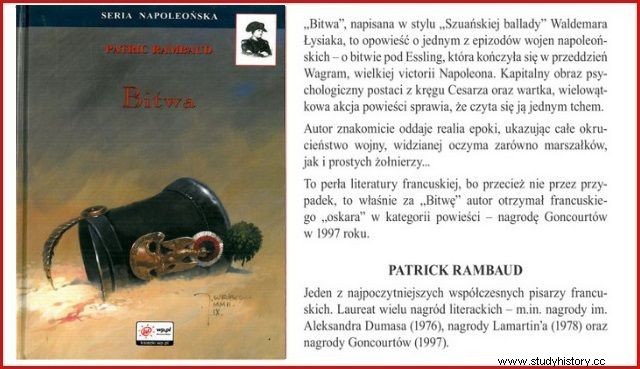Battle of the nations at Leipzig? Waterloo? No, the fate of the French emperor changed much earlier. On May 22, 1809, at Essling, he transformed from the invincible god of war into an ordinary, fallible commander. For the first time, he lost in an equally important match. His humiliating defeat became a crack in his wartime fame and aroused the hopes of all his opponents.
The fifth coalition (1808–1809) certainly pushed Napoleon on the defensive. The war in the Iberian Peninsula was starting to take a decidedly bad turn. The endless struggle against the Spanish guerrillas and the Portuguese, supported by the British, required a great deal of effort, people and money. As if that were not enough, Austria also declared war on France, determined to avenge the defeat at Austerlitz.
The Habsburg Monarchy had a sizeable and newly reformed army and subsidies from Britain. Although Prussia did not join the coalition, the secret agreement with Russia was optimistic. Tsar Alexander, officially an ally of Napoleon, promised that he would not take any hostile action against Austria if it attacked France.
Austrians attack, French take Vienna
In the spring of 1809, the Austrians attacked in three directions:Bavaria, Italy and the Duchy of Warsaw. Only two years old, resurrected alongside Napoleon , the Polish state faced great danger .
After the conquest by Archduke Ferdinand, Habsburg-Este was to become a "gift" for the Prussians, to finally convince them to declare war on the French Emperor.
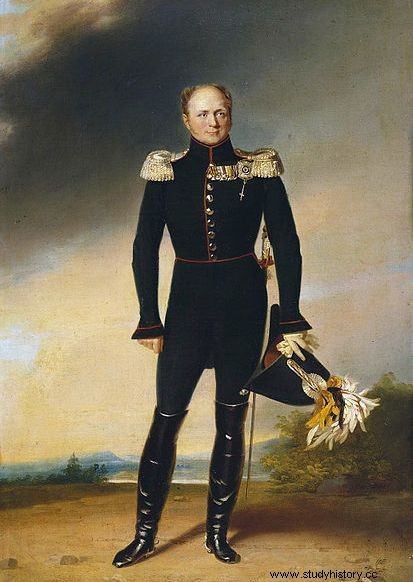
Thanks to Tsar Alexander's declaration, the Austrians were able to attack Napoleon (source:public domain).
The momentum of the offensive was small, however, and Napoleon appeared at the front a week after the declaration of war, immediately taking command of the German Army. Soon he defeated the Austrians at Eckmühl, while the Poles won victories at Grochów and Radzymin. In Italy, the Emperor's stepson, Prince de Beauharnais, also triumphed. Vienna fell on May 13 .
General Danube
The French still had to break up the considerable forces of Archduke Charles, and for this they had to cross the Danube. The bridges, of course, were destroyed by the Austrians. The island of Lobau was chosen for the crossing, providing cover during the construction of pontoon bridges. Two were constructed, connecting the island with both banks of the river.
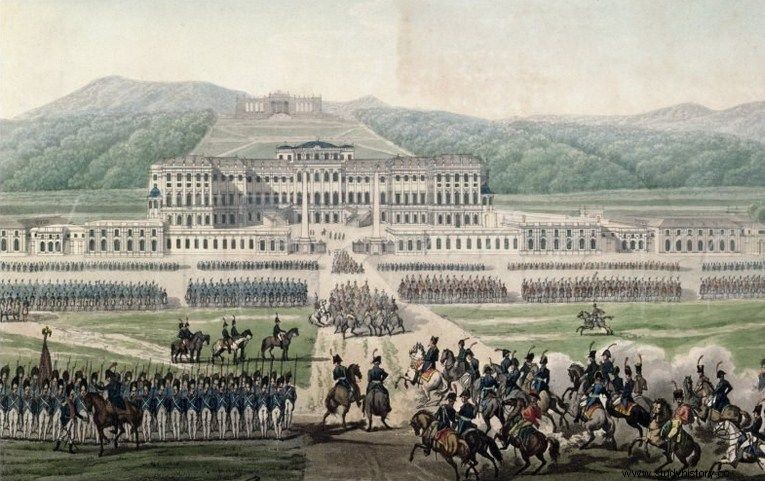
Initially, the Austrians had no reason to be satisfied. On May 13, 1809, Vienna fell. In the illustration, Napoleon arrives at the Schoenbrunn Palace - the summer residence of the Habsburgs (source:public domain).
The May time was quite difficult with this great logistics operation. The Danube grew in the eyes, which threatened the whole project. It was decided to ignore this, which turned out to be quite a mistake . Later, gathering his thinned army in the pouring rain, Napoleon was to say that he had lost to General Danube.
The strength of both armies was equal, both also had many inexperienced recruits in their ranks. Archduke Charles was no less capable commander than the French Emperor, but was characterized by long-term disastrous conservatism . He was also not trusted by his Imperial brother or even his own generals.
Bloody mess
Fighting raged for the capture of the villages of Aspern and Essling on the Austrian-controlled side of the Danube. The wounded were carried continuously to the field hospitals on Lobau.
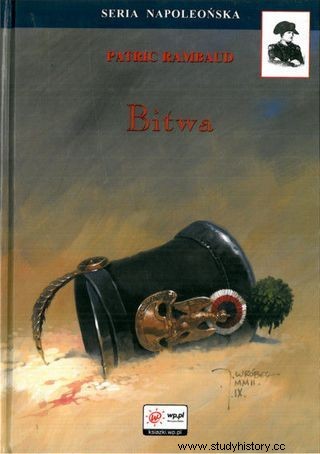
This article was inspired by Patric Rambaud's book "Battle" (Finna 2015).
Here is how this horror scene is described by Patrick Rambaud, author of "The Battle" dedicated to the clash:
The rattle, crying, groaning, sobbing, screaming, and singing of the wounded from Lobau Island had nothing to do with nostalgia. Dressed in incomplete uniforms, devoid of feelings, paramedics squashed with their hands swarms of flies on the wounds.
Doctor Percy, in a long apron and his hands drenched in blood up to his elbows, lost much of his good-naturedness (...) himself, not being able to look after all the cripples and wounds, he marked the twisted pain in the bodies, fragments that needed to be amputated; random assistants sawed, sometimes too close to joints, breached living bones, blood spurted (…).
Many died of cardiac arrest, others were bleeding out of an unfortunate cut artery ”.
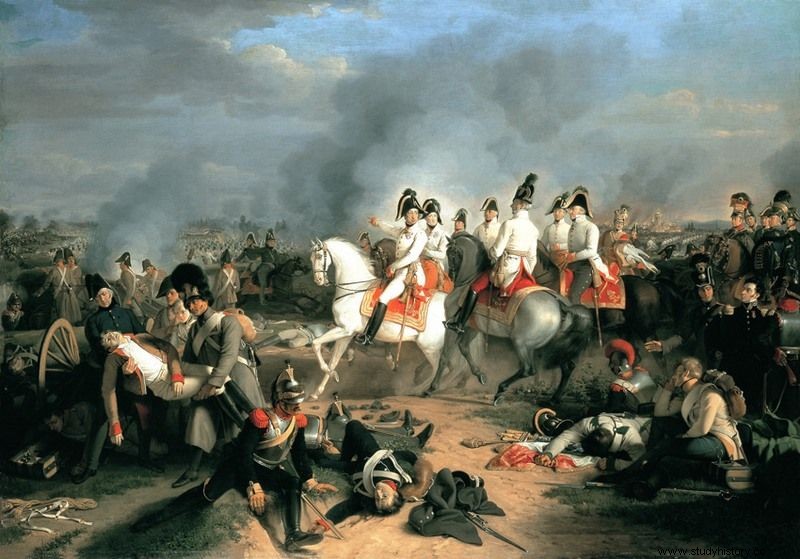
Archduke Charles with his staff during the Battle of Essling (source:public domain).
During the Battle of Essling, there was a massive use of artillery, which would later become the main symbol of the Battle of Wagram. Cannonballs crushed people, set fire to and destroyed buildings, decimated both infantry and cavalry. Both ordinary soldiers and eminent French marshals, the closest and most talented commanders of Napoleon, died from them. Their flower has fallen under Essling.
Prince Lannes, one of the few who could refer to the emperor as "you", was ricocheted in the legs and died of infection after suffering long. General Espagne died on the first day of the battle, which was foretold by an apparition known as the White Lady of the Habsburgs.
Freshly baked marshal (for his services from Eckmühl) Saint-Hilaire died of an infection that got into a leg torn off by a cannonball. The beautifully dressed, well-groomed, and proud grenadiers of the Young Guard corps were dying like flies under fire.

The Battle of Essling cost the lives of many of Napoleon's talented officers. Prince Jean Lannes was also among them. Pictured is a painting by Albert Paul Bourgeois (source:public domain).
The unlucky bridge
The French had big problems with supplies and retrieving supplements. Breaking the bridges connecting Lobau with both banks was a real plague. Not only were the forces of nature raging against the structure, but also the Austrians pushed boats filled with stones down the river, and even larger structures smeared with tar and set on fire.
With the cavalry charge on the enemy's center, victory seemed within reach, the bridge was once again broken.

This article was inspired by Patric Rambaud's book "Battle" (Finna 2015).
At this point, it is worth quoting again the fragment from the "Battle" describing this situation:
Napoleon's pale, almost translucent face showed an undisturbed calm, resembling an unfinished sculpture. (...) He was standing at the abutment of a broken bridge that swayed on the water like a boat (...)
The emperor, more depressed than irritated, silently stared at the back of his hands as he gripped his riding crop. Circumstances were favorable to him that morning, and everything indicated that the offensive would be successful (...).
He was getting an attack of madness at the sight of Davout's army stuck motionless on the other bank with a park of useless cannons, carts with dust and food, all that column of people he couldn't make any use of .
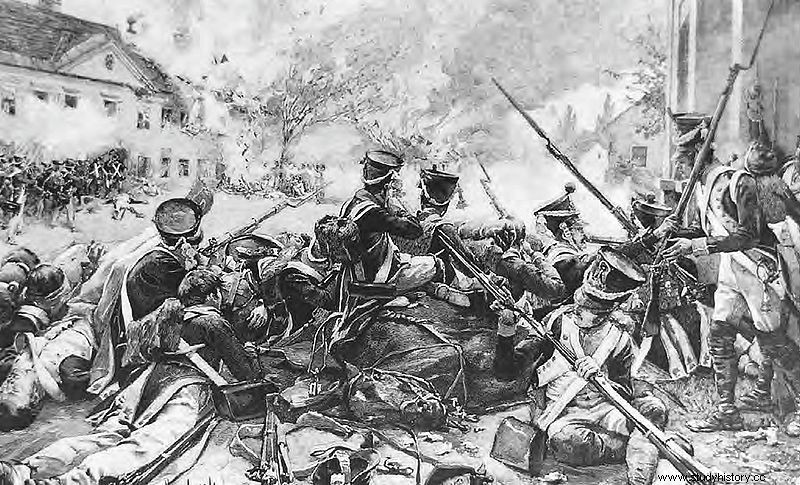
Street fights in Essling. Drawing by F. de Myrbach (source:public domain).
The Austrians immediately regained their faith in the victory. Only the Lobau artillery cover and the frenetic attacks of the Young Guard stopped the total slaughter of the Grand Army . The already mentioned procrastination of Archduke Charles also decided. Sensing the ambush, he decided not to strike frontally and push the French into the depths of the Danube. During the night, Napoleon's last forces crossed over to the Lobau and then demolished the bridge connecting them to Aspern and Essling.
Defeat postponed
With the loss of the second bridge, the army was stuck on the island for three whole days. The battle ended in defeat for the French, and bells were ringed in nearby Vienna. Europe believed Napoleon could be defeated after all. There was an attempted assassination attempt on the emperor in the fall. A young German, Friedrich Staps, wanted to stab the emperor during the military parade in front of Schönbrunn Palace.
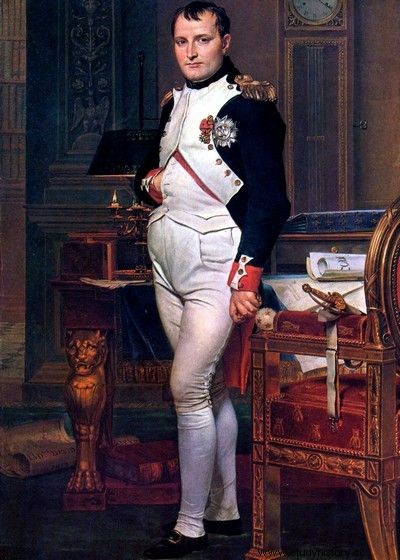
The Battle of Essling showed Napoleon's not invincible at all (source:public domain).
Ultimately, the Corsican avoided both the loss of the Grand Army and the loss of his own life. Even before the attack, he regained his strategic initiative and, after the victorious battle of Wagram, imposed humiliating peace on Austria.
We had to wait a few more years for the end of the Napoleonic order in Europe. The Austrians, however, still praise to the heavens their hero from Aspern, Archduke Charles, the ancestor of the Zywiec polonized Habsburg line.
You can buy the book in Empik stores:
